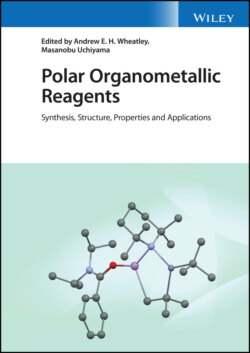Читать книгу Polar Organometallic Reagents - Группа авторов - Страница 16
1.2.2.2 Group 1/2 Reagents
ОглавлениеIn 2006 Knochel et al. augmented the synthetic toolbox available to chemists by improving on Hauser bases through the introduction of a lithium salt. The resultant family of R2NMgCl(LiCl) reagents has become known as turbo‐Hauser reagents. They were prepared by combining i‐PrMgCl(LiCl) 40 with i‐Pr2NH or HTMP and displayed a range of benefits. It was quickly perceived that, unlike many straightforward magnesium amide compounds, they show excellent THF solubility at e.g. room temperature, avoid the need of traditional bases like organolithiums for the use of depressed temperatures (of −78 °C or so), which complicates scale‐up, and exhibit kinetic basicity so enabling the regioselective magnesiation of heterocyclic substrates [65]. For example, the selective deprotonation of pyrimidines has typically proved challenging on account of competing addition reactions exhibited by many organometallics. However, pyrimidine derivatives reacted smoothly with TMPMgCl(LiCl) 41 in THF at 55 °C to afford putative selectively magnesiated intermediates 42 (Scheme 1.11, top) that could be worked‐up with a range of electrophiles – a strategy that subsequently underpinned the successive regio‐ and chemoselective elaboration of halogenated pyrimidines [66]. Similar reactivity was reported for pyridines, quinolones, and isoquinolines, as well as for heterocycles like thiazole, thiophene, furan, benzothiophene, and benzothiazole heterocycles that bear relatively acidic hydrogens. This work led, later the same year, to the deployment of turbo‐Hauser reagents in directed ortho‐magnesiation [67]. Impressively, the direct magnesiation of highly functionalized aromatics bearing esters, nitriles, or ketones was achieved through the mediation of an easily introduced/removed OBoc (Boc = tert‐butoxycarbonyl) directing group. The compatibility of this approach with, for example, keto groups enabled the fabrication of a putative meta‐magnesiated benzophenone 43 in high yield at −20 °C, ready for subsequent electrophilic quenching (Scheme 1.11, bottom).
In spite of the significant advantages to be had by using R2NMgCl(LiCl)‐type reagents, it was quickly seen that some moderately activated aromatics, e.g. tert‐butyl benzoate, reacted only modestly. This observation led to the development of a new class of mixed Li/Mg base. The reaction of R2NLi and MgCl2 in THF at 0 °C afforded (R2N)2Mg(LiCl)244. Whereas 41 failed to react significantly (7% ortho‐iodination after quenching with I2) with t‐BuO2CPh, 44 [amide = TMP, t‐Bu(c‐C6H11)N, t‐Bu(i‐Pr)N] performed excellently (77–90% ortho‐iodination). The tolerance of e.g. 44 TMP towards ketone, carbonate, and bis(dimethylamino)phosphonate groups allowed intriguing new applications in ortho functionalization. For example, the OP(O)(NMe)2 group selectively directed 4‐deprotonation via assumed 45 to give 46 on quenching. Moreover, the magnesiation of electron‐rich aromatics was made significantly more accessible than had hitherto been the case. This has been utilized to ortho‐magnesiate dimethyl‐1,3‐benzodioxan‐4‐one to give 47 in just 10 min at −40 °C en route to the preparation of 6‐hexylsalicylic acid, a natural product found in Pelargonium sidoides DC (Scheme 1.12) [68].
Scheme 1.11 Reactions of TMPMgCl(LiCl) 41 with 5‐bromopyrimidine (top) and a highly functionalized aromatic bearing ester groups (bottom).
Alkali metal magnesiate reagents have been developed recently. Their chemistry will be discussed at more length elsewhere. However, their often unique reactivity merits a summary here. TMEDA‐solvated sodium magnesiates, which have a lot in common with the structural chemistry of THF‐solvated mixed lithium‐magnesium amide complexes [69], initially demonstrated similar structural motifs to those seen in, for example, zincate chemistry (see Section 1.4.2) and elucidated in depth in Chapter 3 [70–72]. Briefly, convoluted chemistry of TMPMg(TMP)(n‐Bu)Na(TMEDA) 48 has been explored with respect to furan, which underwent α‐metalation via the formation of a transient intermediate that disproportionated to the inverse crown disodium dimagnesium hexafuryl tri(THF) complex (TMEDA)Mg2(2‐C4H3O)6Na2(THF)349 alongside TMEDA‐solvated Mg(TMP)3Na 50, the ion‐separated analogue of which ([(TMP)3Mg][Na(PMDETA)2] 51, PMDETA = N,N,N′,N′′,N′′‐pentamethyldiethylenetriamine) proved isolable [71].
Although the chemistries of Grignard and Hauser reagents have long formed a staple of synthetic chemistry, recent interest has focused on their so‐called LiCl‐complexed ‘turbo’ variants. Their excellent solubility and the extensive new array of aromatic functionalizations allowed by these complexes have led to an interest in reagent structure as a means of understanding reactivity. However, it is only lately that the first solid‐state evidence has emerged (see Chapter 2). The turbo‐Hauser monomer (THF)(TMP)Mg(μ‐Cl)2Li(THF)252 was reported in 2008 to ortho‐magnesiate ethyl 3‐chlorobenzoate [73]. Meanwhile, the different reactivities of spirocyclic TMPMg(μ‐Cl)2Li(THF)253 were explained shortly thereafter [74]. Such structural work on turbo‐Hauser bases has been extended to the solution phase using Diffusion Ordered SpectroscopY (DOSY) [75, 76]. This approach has allowed the dissolution of 52 and 53 with retention of aggregation. Elaboration of the DOSY technique allowed the corroboration of ideas posited by the authors of the solid‐state work insofar as turbo reagent reactivity was attributed to the unsaturation of Mg after the loss of THF [77].
Scheme 1.12 Ortho‐magnesiation by TMP2Mg(LiCl)244 TMP of an aromatic bis(dimethylamino)phosphonate and of dimethyl‐1,3‐benzodioxan‐4‐one to give 46 and 47 en route to the preparation of 6‐hexylsalicylic acid.
